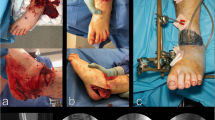Abstract
There is increasing interest in and use of minimally invasive foot surgery (MIFS), as it involves short operating time, quicker recovery, reduced hospital stays, better cosmetic results and fewer complications compared to open surgery. However, limited evidence is available in relation to complications associated with MIS for forefoot deformity correction. Available publications lack of homogeneity in terms of case series, patient selection and clinical indicators, mostly being retrospective observational studies with insufficient randomised control trials. The aim of this study was to report the complications following MIFS. In this evaluation, as the Author conceived it as a feasible tool of current clinical practice, complications can be broadly divided into three categories: (1) those related to the learning curve; (2) typical postoperative clinical conditions, such as oedema and haematoma; and (3) true complications. MIFS procedures are safely performed in a range of clinical settings, on varying degrees of digital deformity, resulting in an overall low complication rate compared to conventional open surgery. Long-term safety and efficacy of these techniques need further scientific validations as well as future treatment algorithms to guide clinical decision making.


Similar content being viewed by others
Bibliografia
Gilheany M, Baarini O, Samaras D (2015) Minimally invasive surgery for pedal digital deformity: an audit of complications using national benchmark indicators. J Foot Ankle Res 8:17
Mathavan G, Gaskell L, Pillai A et al. (2015) Minimal invasive hallux valgus surgery: myth or magic. A systematic review. Orthop Rheumatol Open Access J 1(1):555551
Maffulli N, Longo UG, Marinozzi A, Denaro V (2011) Hallux valgus: effectiveness and safety of minimally invasive surgery. A systematic review. Br Med Bull 97:149–167
Giannini S, Cavallo M, Faldini C et al. (2013) The SERI distal metatarsal osteotomy and Scarf osteotomy provide similar correction of hallux valgus. Clin Orthop Relat Res 471(7):2305–2311
Scala A, Vendettuoli D (2013) Modified minimal incision subcapital osteotomy for hallux valgus correction. Foot Ankle Spec 6(1):65–72
Maffulli N, Longo UG, Oliva F et al. (2009) Bosch osteotomy and scarf osteotomy for hallux valgus correction. Orthop Clin N Am 40(4):515–524
Button G, Pinney S (2004) A meta-analysis of outcome rating scales in foot and ankle surgery: is there a valid, reliable and responsive system? Foot Ankle Int 25(8):521–525
Parker J, Nester CJ, Long AF, Barrie J (2003) The problem with measuring patient perceptions of outcome with existing outcome measures in foot and ankle surgery. Foot Ankle Int 24(1):56–60
Morley D, Jenkinson C, Doll H et al. (2013) The Manchester-Oxford Foot Questionnaire (MOXFQ): development and validation of a summary index score. Bone Jt Res 2(4):66–69
Cazeau C (2009) Chirurgie mini-invasive et percutanee du pied. Sauramps Medical, Paris
De Prado M, Ripoll PL, Golanó P (2009) Minimally invasive foot surgery. Masson, Barcelona
Darcel V (2008) Prise en charge des métatarsalgies statiques par ostéotomie distale percutanée: suivi prospectif de 241 pieds. Thèse de Médecine N° 3081, Université Victor Ségalen Bordeaux 2
Mouton A (2008) Chirurgie percutanée de l’hallux valgus. Résultats d’une étude prospective de 88 interventions. Thèse de Médecine N° 3080, Université Victor Ségalen Bordeaux 2
Bauer T, De Lavigne C, Biau D et al., for the GRECMIP (2009) Percutaneous hallux valgus surgery: a prospective multi center study of 189 cases. Orthop Clin N Am 40(4):505–514
Bauer T, Biau D, Lortat-Jacob A, Hardy PH (2009) Traitement percutané de l’hallux valgus par ostéotomie de Reverdin-Isham: résultats à 2 ans d’une série monocentrique prospective continue de 104 cas. Rev Chir Orthop Réparatrice Appar Mot
Laffenétre O, Cermolacce C, Coillard JY et al. (2005) Mini invasive surgery of hallux valgus. In: Valtin B, Leemrijse T (eds) Cahiers d’enseignement de la SOFCOT: chirurgie de l’avant-pied. Elsevier, Amsterdam, pp 96–104
O’Kane C, Kilmartin T (2005) Review of proximal interphalangeal joint excisional arthroplasty for the correction of second hammertoe deformity in 100 cases. Foot Ankle Int 4:320–325
Butterworth P, Gilheany M, Tinley P (2007) Postoperative infection rates in foot and ankle surgery: a clinical audit of Australian podiatric surgeons, January to December 2007. Aust Health Rev 2:180–185.
Wukich DK, Lowery NJ, McMillen RL, Frykberg RG (2010) Postoperative infection rates in foot and ankle surgery: a comparison of patients with and without Diabetes Mellitus. J Bone Jt Surg Am 2:287–295
Ellington JK, Anderson RB, Davis WH et al. (2010) Radiographic analysis of proximal interphalangeal joint arthrodesis with an intramedullary fusion device for lesser toe deformities. Foot Ankle Int 31:372–376
Di Giorgio L, Touloupakis G, Simone S et al. (2013) The endolog system for moderate to severe hallux valgus. J Orthop Surg 21(1):47–50
Iannò B, Familiari F, De Gori M et al. (2013) Midterm results and complications after minimally invasive distal metatarsal osteotomy for treatment of hallux valgus. Foot Ankle Int 34(7):969–977
Author information
Authors and Affiliations
Corresponding author
Ethics declarations
Conflitto di interesse
Gli autori M. Breccia, S. Ferranti e B. Rossi dichiarano di non avere alcun conflitto di interesse.
Consenso informato e conformità agli standard etici
Tutte le procedure descritte nello studio e che hanno coinvolto esseri umani sono state attuate in conformità alle norme etiche stabilite dalla dichiarazione di Helsinki del 1975 e successive modifiche. Il consenso informato è stato ottenuto da tutti i pazienti inclusi nello studio.
Human and Animal Rights
L’articolo non contiene alcuno studio eseguito su esseri umani e su animali da parte degli autori.
Rights and permissions
About this article
Cite this article
Breccia, M., Ferranti, S., Rossi, B. et al. Le complicanze della chirurgia mini-invasiva dell’avampiede. LO SCALPELLO 30, 187–190 (2016). https://doi.org/10.1007/s11639-016-0178-4
Published:
Issue Date:
DOI: https://doi.org/10.1007/s11639-016-0178-4




